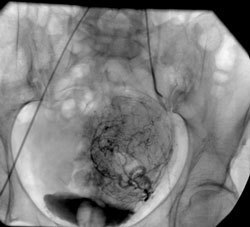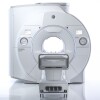Public Not Aware of UFE Treatment
by Barbara Kram, Editor | March 24, 2008

Uterine fibroid embolization
(UFE) is a new way of
treating symptomatic
fibroid of the uterus.
(UFE) is a new way of
treating symptomatic
fibroid of the uterus.
Washington, D.C. -A study presented today at the Society of Interventional Radiology's 33rd Annual Scientific Meeting last week shows of 105 patients in the Atlanta metro area, only 18 percent of the women who saw a private practice gynecologist were told about uterine fibroid embolization (UFE), a minimally invasive treatment for uterine fibroids provided by interventional radiologists. UFE is a safe, effective established treatment that has been widely available for the past decade and is covered by insurance. The majority of women who sought treatment from their private practice gynecologists for uterine fibroids were only offered hysterectomy or myomectomy surgery, which is provided by gynecologists. However, Kaiser Permanente, which standardizes many medical protocols, has its gynecologists discuss all the treatment options with their patients, including UFE.
"The scientific evidence of the safety and efficacy of UFE is irrefutable. In medicine, we present the scientific proof at meetings like this in large groups, but we implement these results as individual physicians. Physicians need to incorporate UFE into the treatment algorithm for patients suffering with uterine fibroids. The patient should not have to be the one to suggest her treatment; that is the physician's responsibility. Gynecologists need to be the ones taking the lead on this, and I applaud Kaiser Permanente's gynecologists for being the only ones in our area to consistently do this," said John Lipman, M.D., director of interventional radiology at Emory-Adventist Hospital in Atlanta.
Of the women who self-referred to interventional radiologists, the majority found out about UFE on their own primarily through the Internet or through a media advertisement. In some cases, they obtained referrals from their gynecologists, but only after asking about the treatment.
"Women suffering with fibroids need to be given all of their options-not just the ones that gynecologists can offer. With UFE, my patients are treated as outpatients, with no hospital stay. They go home with a band-aid and on average recover in four to five days. Many of the surgical patients after hysterectomy are still in the hospital by the time my UFE patients have recovered, and these surgical patients still have six to eight weeks of additional recovery at home," noted Lipman.
Of the 600,000 hysterectomies performed annually in the United States, one-third of these are to relieve symptoms caused by benign fibroids. Uterine fibroids are benign tumors that can cause prolonged, heavy menstrual bleeding that can be severe enough to cause anemia or require transfusion; disabling pelvic pain and pressure; urinary frequency; pain during intercourse; miscarriage; interference with fertility; and an abnormally large uterus-resembling pregnancy.
"The scientific evidence of the safety and efficacy of UFE is irrefutable. In medicine, we present the scientific proof at meetings like this in large groups, but we implement these results as individual physicians. Physicians need to incorporate UFE into the treatment algorithm for patients suffering with uterine fibroids. The patient should not have to be the one to suggest her treatment; that is the physician's responsibility. Gynecologists need to be the ones taking the lead on this, and I applaud Kaiser Permanente's gynecologists for being the only ones in our area to consistently do this," said John Lipman, M.D., director of interventional radiology at Emory-Adventist Hospital in Atlanta.
Of the women who self-referred to interventional radiologists, the majority found out about UFE on their own primarily through the Internet or through a media advertisement. In some cases, they obtained referrals from their gynecologists, but only after asking about the treatment.
"Women suffering with fibroids need to be given all of their options-not just the ones that gynecologists can offer. With UFE, my patients are treated as outpatients, with no hospital stay. They go home with a band-aid and on average recover in four to five days. Many of the surgical patients after hysterectomy are still in the hospital by the time my UFE patients have recovered, and these surgical patients still have six to eight weeks of additional recovery at home," noted Lipman.
Of the 600,000 hysterectomies performed annually in the United States, one-third of these are to relieve symptoms caused by benign fibroids. Uterine fibroids are benign tumors that can cause prolonged, heavy menstrual bleeding that can be severe enough to cause anemia or require transfusion; disabling pelvic pain and pressure; urinary frequency; pain during intercourse; miscarriage; interference with fertility; and an abnormally large uterus-resembling pregnancy.
1(current)









